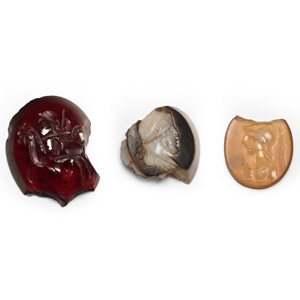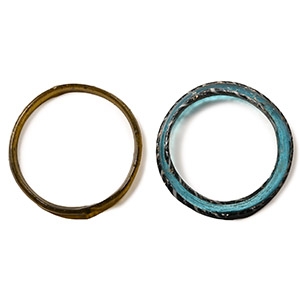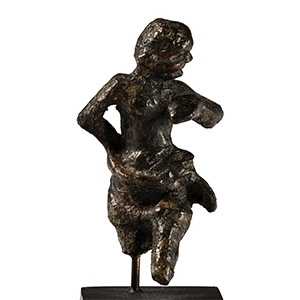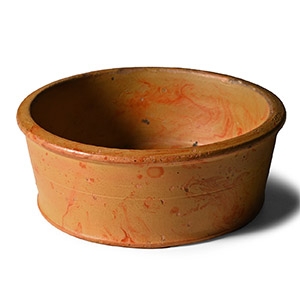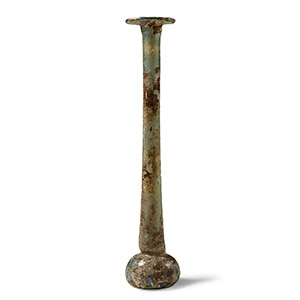Home > Auctions > 26 November - 1 December 2024
Ancient Art, Antiquities, Natural History & Coins
From the collection of a gentleman, acquired on the London art market in the 1990s.
UK private collection before 2000.
Acquired on the UK art market.
Property of a London gentleman.
UK gallery, early 2000s.
Accompanied by a previous certificate of authenticity.
David McAllister's exciting design is a 'one of a kind' work that portrays the might and riches of the Roman civilisation. This limited edition print is a celebration of the award winning artist's lifetime dedication to historical paintings of the ancient world. To enhance appreciation of this rare and historic work, each individual print is signed and numbered by the artist.
From a family collection mostly formed in the 1940s-1950s, thence by descent.
Cf. Whitehouse, D., Roman Glass in the Corning Museum of Glass, vol.2, New York, 2001, item 769, for type.
From a collection acquired on the UK art market from various auction houses and collections mostly before 2000.
From an important Cambridgeshire estate; thence by descent.
Cf. Beutler, F. et al., Der Adler Roms. Carnuntum und der Armee der Cäsaren, Bad-Deutsch Altenberg, 2017, item 757.
From the private collection of Mr K.A., acquired in the 1990s-early 2000s.
From a collection acquired on the UK art market from various auction houses and collections mostly before 2000.
From an important Cambridgeshire estate; thence by descent.
Cf. Barkoczi, L., ‘Deux Tombes de cheval à Brigetio (two horse graves at Brigetio, in Hungarian and French)’, in Archaeologiai Ertesito, series III, Vol.VII-VIII-IX, 1946-1947-1948, Budapest, 1948, pp.169-162, pls.XXVI-XXVII, XXIX, XXXIII, and figs.4-5, for identical mounts.
The two mounts are elements of horse harness decorating the antilena and postilena of the horse, as intersection fittings of the main straps. According to Alfoldi, these horse harnesses were the product of a metallurgy that was the fruit of a Gallo-Roman revival, and not exclusively of military nature. The military adopted similar elements fruit of the revival of this Celtic-Roman decorative art, since such harnesses have also been discovered in border fortresses. But the large industrial centers, which worked for export, manufactured objects primarily for the Danubian regions where both the soldiers and the civilian population, without distinction of class, used them as habitual objects.
From a family collection mostly formed in the 1940s-1950s, thence by descent.
From a collection acquired on the UK art market from various auction houses and collections mostly before 2000.
From an important Cambridgeshire estate; thence by descent.
Maenads were followers of Dionysus whose rites were characterised by vigorous dancing to loud music and crashing cymbals, in which the revellers whirled and became drunk, and incited each another to greater abandon.
Acquired 1960s-1990s.
From the late Alison Barker collection, a retired London barrister.
See Bussière, J., Lindros Wohl, B., Ancient Lamps in the J. Paul Getty Museum, Malibu, 2017, nos.493-500, p.35.
The lamp belongs to the type Atlante X or Hayes II A. The so-called Christian lamps in Terra Sigillata Africana have been classified by Hayes into two major types, I and II. He has distinguished two classes in his type II, according to geographic place of manufacture or origin. Subtype II A group lamps from central Tunisia are characterised by the use of fine clay, glossy light orange slip, and carefully executed decoration using a great number of neatly drawn shoulder motifs. The image of this military officer is unusual, and it can represent an imperial primikerios of the African army after the reconquest of Belisarius in 533 A.D.
Ex West Country specialist collection of Roman pottery, UK, 1990s.
From a London, UK, collection, 1990s.
Cf. Whitehouse, D., Roman Glass in the Corning Museum of Glass, vol.2, New York, 2001, item 772. for type.
637 - 648 of 3419 LOTS






